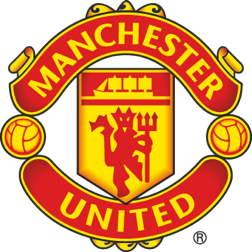Eddie Colman: The first rock 'n' roll footballer?
It’s often stated, as if fact, that George Best was the first rock ’n’ roll footballer.
With those looks, that Beatle-esque haircut and a wildly exciting playing style, he certainly remains the ultimate rock ’n’ roll footballer.
But rock ’n’ roll was around long before the Belfast boy started to dazzle the swinging sixties. And also around long before that decade of giddy liberation was the determined desire of young people to express themselves. To find an outlet for their energy and their enthusiasm for life.
Rock ’n’ roll delivered its first seismic shock to the UK in November 1955, as Bill Haley and the Comets’ vibrant anthem Rock Around the Clock rose to no.2 in the charts. At that time, United’s rising ‘Busby Babes’ were the closest thing English football had, when it came to a similar explosion of youthful exuberance.
And making his debut that same month was a teenager from Salford named Eddie Colman, who would soon become the personification of the team’s swagger and confidence and, above all, its sense of fun.
Why we loved Eddie Colman Video
Why we loved Eddie Colman
Learn more about Eddie Colman, the United legend who was nicknamed 'Snakehips'...
Salford then was little like the place it is today. Walk across from Old Trafford to the Quays now and you’ll be assaulted with neon signs, stylish steel facades and a multitude of amusing ways to spend your time and money.
But when Eddie started to flourish as a footballer, first for Salford Boys and then Manchester United’s youth sides, it was still a hard, dark, fiercely working-class place, where entertainment was simply playing ball games outside, or a game of cards in the family living room.
A yearning for enjoyment, however, still raged among its people. And when you watched Eddie play, you felt that more than anything. One of Colman’s great mates was former United player and manager Wilf McGuinness, who played in the same position as Eddie and spent countless hours in his company.
“The two of us had plenty in common,” wrote Wilf, in his autobiography Manchester United: Man and Babe. “But football-wise we offered a vivid contrast, even though we were both wing-halves. While I was principally a tackler and a runner, Eddie was a creator and a crowd-pleaser, a gifted playmaker who had a knack of making space by throwing a dummy or executing a delicate drag-back, then finding a team-mate with a perfectly directed pass. He had total mastery of the ball, his footwork was twinkling and he was pure joy to watch.”
Colman quickly acquired the nickname ‘Swivel Hips’ or ‘Snake Hips’, for his ability to shimmy past opponents. Jimmy Murphy later described him as “the player with the wiggle like Marilyn Monroe.”
The United States might have had Elvis Presley, aka ‘Elvis the Pelvis’, but now M16 had its own equivalent.
Off the field, Eddie was no less entrancing. His family lived on Archie Street, a row of terraces in Ordsall – visible in the original intro to Coronation Street – and their house acted as a social centre for many of the young Reds, given its proximity to both Old Trafford and the old training ground at The Cliff.
“Eddie would always ask me to spend Christmas Eve at Archie Street, which was wonderful,” recalled Sir Bobby Charlton, another of Colman’s great pals. “But [it was] quite hazardous once I had made the reserve team and we both had to play on Christmas Day, especially as the kick-off was 11am. We protested that we had to go to bed early, but it wasn't so easy when Eddie's Uncle Billy, who was a fine singer, arrived in full voice.
“‘You can't go to bed,’ the Colmans cried. ‘Uncle Billy wants to sing for you – and he's the best singer in the world.’ To fuel the celebrations, at short intervals someone went to the off-licence on the corner of the street, with a white enamel bucket to be filled with beer.”
Away from the cosiness of the family home, Eddie loved a pint, a laugh and the pop music of the day. Look at almost any photo of him and you can see his radiant effervescence bursting forth; a lust for all that life has to offer. There’s a great one from the Blue Stars international youth tournament in Switzerland in 1954, where you can interpret that Eddie’s making a wisecrack about a bouquet of flowers that has just been presented to skipper David Pegg.
He seemed to attack every area of life with the same vivaciousness.
He seemed to attack every area of life with the same vivaciousness.
“Eddie loved the music of Sinatra and all the emerging rock ’n’ roll stuff,” explained Wilf. “He was a great jiver, unlike Bobby and myself. To be strictly fair, Bobby wasn’t too bad, and I tried my best, but I must have cut a ridiculous figure as we jumped about on the dancefloor.
“Inevitably, Eddie became our social secretary, planning visits to such venues as the Bodega jazz club near the old Manchester Evening News offices on Cross Street, where often George Melly was on the bill; the Plaza; the Ritz and the Sale Locarno. Nearly all the players socialised most of the time, spending hours at coffee bars such as Lyons and the Kardomah. In those days the shops shut at lunchtimes and on Wednesday afternoons, so we’d be there to meet the shop girls when they went off duty.”
“Inevitably, Eddie became our social secretary, planning visits to such venues as the Bodega jazz club near the old Manchester Evening News offices on Cross Street, where often George Melly was on the bill; the Plaza; the Ritz and the Sale Locarno. Nearly all the players socialised most of the time, spending hours at coffee bars such as Lyons and the Kardomah. In those days the shops shut at lunchtimes and on Wednesday afternoons, so we’d be there to meet the shop girls when they went off duty.”
The night before the Babes’ very last match on UK soil – an immortal 5-4 victory over Arsenal at Highbury – team-mate Albert Scanlon remembered going to the cinema with Eddie to watch the film Pal Joey, in which Sinatra sings the song The Lady Is a Tramp. After the vocal had finished, Eddie stood up in the cinema and applauded for almost 10 minutes, according to Scanlon.
Nowadays, younger generations might think of Sinatra as the embodiment of a kind of stuffy, old-fashioned, reserved kind of sophistication. But in the mid-fifties, he was the supreme manifestation of hip and cool. His musical personality was not in any way lightweight – no matter how many Michael Buble cover versions might have convinced people otherwise. His performances regularly hinted at the kind of deep passions, identity crises and agonising personal wounds that would be explored more openly and more directly by the more emboldened pop musicians of the mid-to-late 1960s.
But in the time before the easing of social conventions, before the changes and relaxations of the 1960s, flamboyance and cool and expression often had to be funnelled shrewdly, codedly through things like tone, language, music and fashion. And football, of course.
At Old Trafford, Colman and his midfield partner Duncan Edwards were the creative, expressive hub of the Babes team that won the league by 11 and eight points in 1955/56 and 1956/57, respectively.
Their confidence and aura first seduced Manchester, and eventually, the entire nation. It wasn’t just what they did, but the way that they did it. Style. Attitude. Panache.
Their confidence and aura first seduced Manchester, and eventually, the entire nation. It wasn’t just what they did, but the way that they did it. Style. Attitude. Panache.
Edwards is widely accepted as the side’s greatest player, and was just 21 years old at the time of his tragic passing, 15 days after the crash. But it’s less often noted that Eddie was the youngest of the eight first-teamers to die, born a month after Duncan in November 1936. Still, by the time of Munich, he had already made 108 appearances for United.
“You could hear the effect they had on the terraces,” praised Bobby Charlton, “Make excitement, create colour, [Matt Busby] told his young players and you only had to listen to the noise of the crowd, the expectant buzz when Duncan or Eddie got on the ball and the huge roars when those moments of promise were beautifully fulfilled, to know that his demands were being met quite perfectly. If Busby wanted United to be a work of art, Duncan was supplying the wonderfully bold brush strokes and Eddie was performing a series of inspired squiggles.”
Perhaps the only criticism you could make of Colman’s precocious young talent was that he scored just twice in senior football. But Eddie even turned that into something fun.
After scoring his final United goal – in the 2-1 win over Red Star Belgrade in early 1958 – he was asked by the Daily Express journalist Henry Rose what it felt to score such an important goal. “You know me, Henry,” Eddie replied. “I’m the most dangerous player in the world from two yards!”
After scoring his final United goal – in the 2-1 win over Red Star Belgrade in early 1958 – he was asked by the Daily Express journalist Henry Rose what it felt to score such an important goal. “You know me, Henry,” Eddie replied. “I’m the most dangerous player in the world from two yards!”
Duncan Edwards: The total footballer
ArticleHere's an essential read for all Reds - a tribute to the man regarded by Sir Matt Busby as "the most complete player."
When George Best made his own United debut, five years after Munich, the Beatles’ timeless, rampaging She Loves You was at no.1. Had he lived, Eddie would have been just 26.
In the prime of his footballing life but still very much a young man, he would have undoubtedly been ready to embrace all the fun and the fizz that was to come, as the new clubs sprang up in Manchester; as music and culture began to open up a world of ideas and excitement; as fresh opportunities began to flow for footballers of supreme talent.
Already, in the relatively closeted 1950s, before footballers were celebrities, before they appeared dancing on Top of the Pops – as Best did in 1965, to the Rolling Stones’ The Last Time – Colman was embracing cutting-edge fashion like drainpipe trousers, velvet collars and the teddy boy haircut. He was hungry for everything.
The sound and energy of the Beatles and the Stones might have been something new, but the impulse behind it all was as old as the River Irwell. Young people, as always, were looking for ways to escape, to find release through film, sound, image, fashions, humour, whatever.
Walk around the streets of Salford Quays now, and it’s hard to escape the feeling that Eddie Colman would fit right into this world. A world of greater freedoms, where leisure and fun are prioritised. Had he been 21 in 1989, he’d no doubt have embraced the Roses and the Mondays like Ryan Giggs and Lee Sharpe did; in 2019, he’d surely have been the kind of young kid rhyming along to Aitch.
Tragically, he never lived to see and enjoy the subsequent decades. Not the one that made Best a star, nor the ones that saw the links between football and youth culture grow ever closer.
But he endures, as the swinging, shaking, effervescent embodiment of the joyous phenomenon that was, and is, the Busby Babes.
But he endures, as the swinging, shaking, effervescent embodiment of the joyous phenomenon that was, and is, the Busby Babes.




